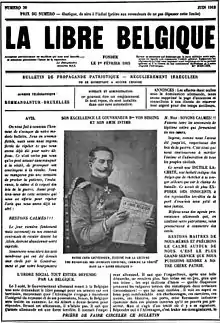La Libre Belgique
La Libre Belgique (French: [la libʁ bɛlʒik]; literally The Free Belgium), currently sold under the name La Libre, is a major daily newspaper in Belgium. Together with Le Soir, it is one of the country's major French language newspapers and is popular in Brussels and Wallonia. La Libre was founded in 1884 and has historically had a centre-right Christian Democratic political stance. The papers is particularly celebrated for its role as an underground newspaper during World War I and World War II when Belgium was occupied. Since 1999, the newspaper has become increasingly liberal but is still considered more conservative than Le Soir.
 | |
| Type | Daily newspaper (six times per week) |
|---|---|
| Format | Compact |
| Owner(s) | La Libre Belgique S.A. |
| Publisher | IPM Advertising |
| Editor | Dorian de Meeûs |
| Founded | Le Patriote: 1884 La Libre Belgique: 1915 |
| Political alignment | Centre-right |
| Headquarters | Rue des Francs 47, B-1040 Brussels, Belgium |
| Circulation | 23,198 (2022) |
| Website | www |
History

The modern La Libre traces its origins to the Le Patriote newspaper, founded by Victor and Louis Jourdain in 1884. Politically, the newspaper supported the dominant centre-right Catholic Party.[1]
After the German invasion of Belgium in World War I, Le Patriote was banned by the German occupation authorities. In February 1915, however, it was re-founded in secret by the Jourdain brothers as an underground newspaper called La Libre Belgique ("Free Belgium"). The new title was an allusion to a collaborationist paper called La Belgique ("Belgium"). A total of 171 issues of La Libre Belgique appeared during the occupation.[2] It soon became famous as an example of Belgian resistance. Several weeks before the end of the hostilities, both of the Jourdain brothers died of natural causes. Their work was continued by Victor’s two sons Joseph and Paul Jourdain.
The newspaper was also published secretly in German-occupied Belgium during World War II in a number of unofficial editions. The largest, known as the La Libre Belgique of Peter Pan (after the fictional editor's name given on the masthead) achieved a circulation of 10,000 to 30,000 copies. 85 bi-monthly issues were published.[3]
After the war, La Libre Belgique supported the mainstream Christian Social Party and, until 1999, the paper had a strong Christian Democratic stance. Currently the newspaper has a centrist editorial policy.[4]
La Libre today
La Libre is published six times per week (from Monday to Saturday) by the IPM publishing group[5][6] and has its headquarters in Brussels.[4] The current editor in chief is Dorian de Meeûs. An online edition of the paper was started in 2001.[7] The paper has been published in a Compact format since 2002.[4][7]
La Libre was noted widely as one of the papers involved in a feud with Google relating to which content that could be linked and cached by Google. In July 2011, the paper was totally removed from Google News and Google's normal web search.
Circulation
La Libre Belgique reached a record circulation of 190,000 copies in 1959. In 1990 the paper sold 170,000 copies.[8] However, by 1999 it had dropped to 68,212 copies. The 2002 circulation of the paper was 61,463 copies with a market share of 9.6 percent.[9] The circulation of the paper was 42,000 in copies in 2010.[4] In 2016, the paper had a circulation of 35,500 with an online traffic of 1-5 million.[10] In 2022, the paper had a circulation of 23,198 copies according to official IPM documents.
Films
Aspects of the newspaper's history reflecting the Belgian Resistance appeared in the 1942 feature film Uncensored and the 1941 documentary short Out of Darkness, part of The Passing Parade series.
See also
References
- "Communicating Europe Manual: Belgium" (PDF). European Stability Initiative. July 2010. Retrieved 1 May 2015.
- Laporte, Christian (1 August 2014). "Du "Patriote" à "La Libre Belgique"…". La Libre. Retrieved 27 July 2017.
- "La Libre Belgique". The Belgian War Press. Cegesoma. Retrieved 27 July 2017.
- "La Libre Belgique". Euro Topics. Retrieved 19 February 2015.
- "Belgian French-language news publishers, authors societies and Google reach partnership agreement" (PDF). Copie Presse. Brussels. 13 December 2012. Retrieved 19 February 2015.
- Georgios Terzis, ed. (2007). European Media Governance: National and Regional Dimensions. Intellect Books. p. 74. ISBN 978-1-84150-192-5. Retrieved 21 February 2015.
- "La Libre Belgique". VoxEurop. Retrieved 19 February 2015.
- Pierre Musso; Philippe Souêtre; Lionel Levasseur (1995). The Printed Press and Television in the Regions of Europe. Council of Europe. p. 133. ISBN 978-92-871-2807-2. Retrieved 19 February 2015.
- David Ward (2004). "A Mapping Study of Media Concentration and Ownership in Ten European Countries" (PDF). Dutch Media Authority. Archived from the original (PDF) on 12 August 2014. Retrieved 12 August 2014.
- "La Libre Belgique". Euro Topics. Retrieved 27 July 2017.
Further reading
External links
- Official website (in French)